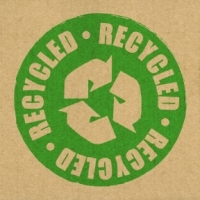It doesn't take a rocket scientist to observe that everything in our culture is beginning to go green: cars, furniture, food, paper, electronics and other industries are changing their outlook on what it means to be "environmentally-friendly." Packaging is no different. In fact, packaging is the main source driving the green market. Come to think of it, packaging is probably one of the most important industries to contribute to the demand of going green. Comprehensively, let's sift through the green-washing, the mixed terminology and the misguided connotations of what "going green" really means for packaging.

Quick Guide to Green Packaging Terms:
Bagasse: The remains of sugar cane pulp after the juice is extracted. This is used to make bio-products such as packaging supplies, paper products, and absorbent products.
Biocompostable: Paper and Plastic products, which will biodegrade and disintegrate completely and safely when put into a municipal or commercial facility (like yard waste or food scraps). This action is usually completed within 90 days however, it will be faster if products are in smaller pieces.
Biodegradable: Products that, over time, will disintegrate completely back into the earth as its original organic components. This process usually is caused by bacteria or sunlight.
Bioplastic: Plastics made from corn, potato or other annually renewable sources which are compostable and biodegradable.
Carbon Footprint: A measure of impact on the environment in terms of the amount of greenhouse gases produced, measured in units of carbon dioxide.
Compost: A mixture of various decaying organic substances, such as dead leaves, that will usually be used for fertilizing soil.
Conservation: Preserving and renewing, when possible both human and natural resources.
Landfill: An area where waste is dumped and eventually covered with dirt and topsoil.
Eco-Efficiency: The ability to do more, with less of our resources, such as using candles instead of lightbulbs, or opening windows instead of using the air conditioner.
Recyclable: Materials or products that, after serving their original purpose, still have usable physical or chemical properties. These items can be reused or remanufactured to make new products.
Source Reduction: Source Reduction, also know as "waste prevention," is the practice of designing, manufacturing, purchasing, or using materials (such as products and packaging) in ways that reduce the amount or toxicity of trash created. Reusing items is another way to stop waste at the source because it delays or avoids that item's entry in the waste collection and disposal system.
With that quick terminology guide on your hands, coupled with all green buying guides for household products, the idea of "going green" can sometimes be overwhelming, can't it? Especially those who are not used to the concept, what it means or just how much commitment it entails. Some fun facts to keep in mind that may truly shock you when it comes to the packaging industry:
[pricing_table columns="3"] [pricing_column title=""]
- [price_info cost="#1"]Sustainable Packaging policies have grown 13 percent in 3 years.[/price_info]
[/pricing_column] [pricing_column title="" highlight="true"]
- [price_info cost="#2"]Packaging makes up one-third of consumer trash in the United States.[/price_info]
[/pricing_column] [pricing_column title=""]
- [price_info cost="#3"]Each United States citizen produces approximately 4.5 pounds of waste per day.[/price_info]
It's obvious. Being green means being committed. It means being committed to finding alternative sources, reusable products and ground-breaking technology. It means being steadfast in the pursuit of decreasing packaging processes, from the packaging itself to the transportation of the product.
This right and duty not only falls on the shoulders of the global community, but on the decision makers in key industries. So, as a packaging professional, how do you define going "green?" What steps have you made to go green this year with your packaging operation? Do you have questions regarding what it means to actually be committed to your company's green initiatives for the 2012 year?


